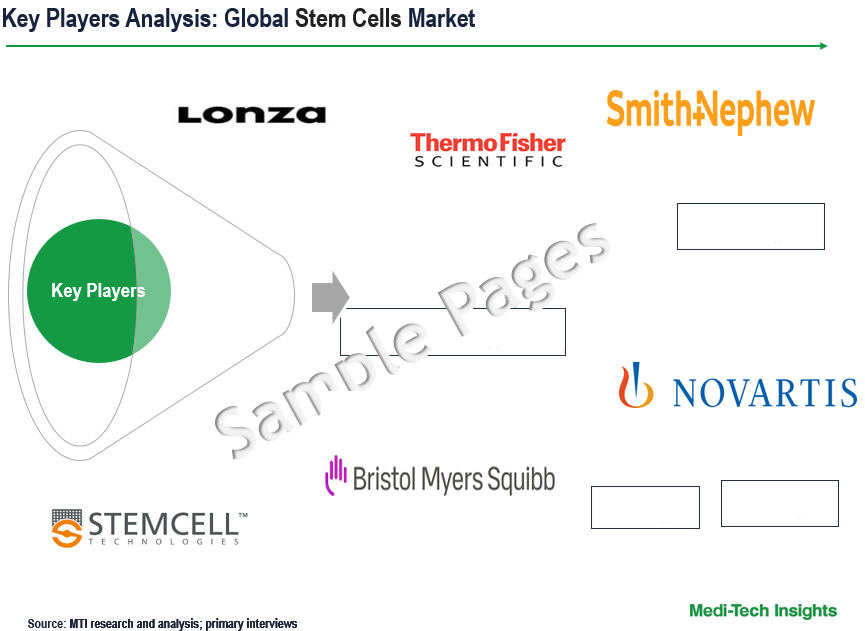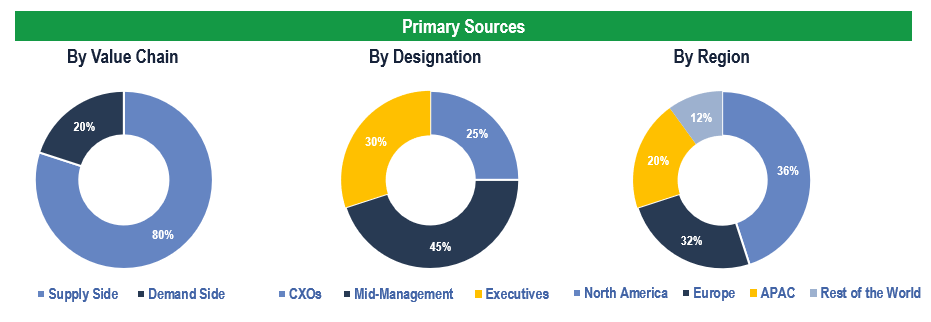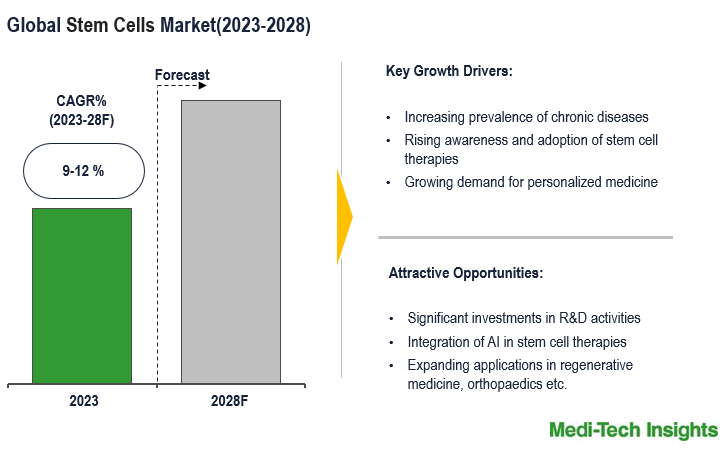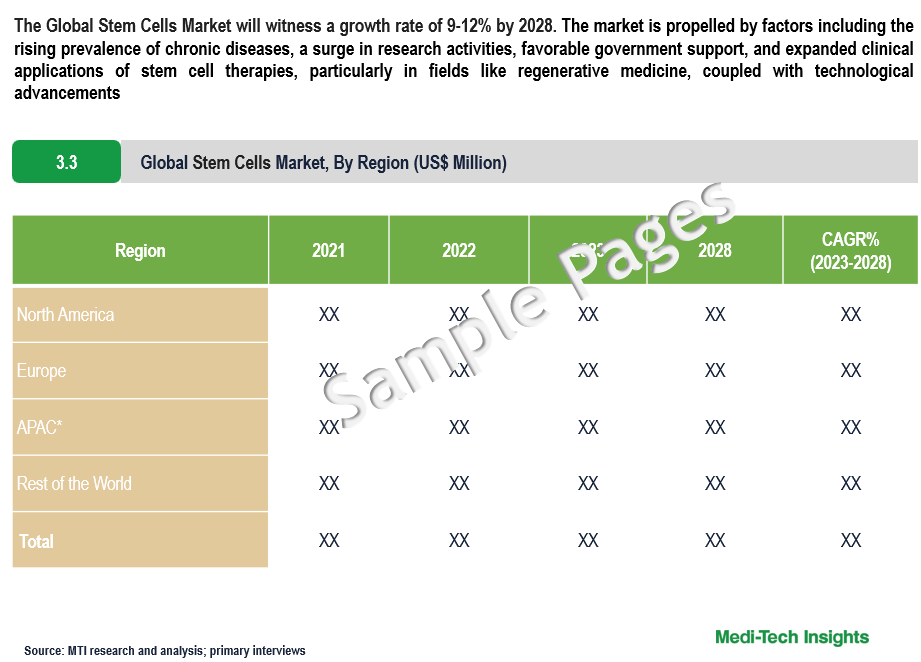
Stem Cells Market Size, Future Trends, Industry Outlook and Forecast to 2028
The Global Stem Cells Market will witness a growth rate of 9-12% by 2028. The market is propelled by factors including the rising prevalence of chronic diseases, a surge in research activities, favourable government support, and expanded clinical applications of stem cell therapies, particularly in fields like regenerative medicine, coupled with technological advancements. To learn more about the research report, download a sample report.
Stem cells are undifferentiated cells with the unique ability to differentiate into specialized cell types. They serve as the building blocks of the body, playing a crucial role in tissue development, repair, and regeneration. Stem cells are classified into two main types: embryonic stem cells, derived from embryos, and adult or somatic stem cells, found in various tissues throughout the body. The pluripotent nature of stem cells makes them valuable for medical research and potential therapeutic applications, including regenerative medicine, treating diseases, and understanding developmental processes. The ethical considerations associated with the use of embryonic stem cells have led to ongoing research into alternative sources, such as induced pluripotent stem cells, generated by reprogramming adult cells. Stem cell research holds great promise for advancing our understanding of biology and revolutionizing medical treatments in the future.
Transformative Horizons: Opportunities and Dynamics in the Stem Cells Market
The global stem cells market exhibits dynamic growth, shaped by diverse factors, including a surge in research activities, and increasing investments, significantly contributing to market expansion. The rising prevalence of chronic diseases propels the demand for innovative stem cell therapies, establishing these conditions as pivotal for market growth. Continuous advancements in stem cell technologies play a crucial role in enhancing their therapeutic potential, serving as a compelling force for market expansion. Additionally, the expanded applications of stem cells in regenerative medicine emerge as significant contributors, offering innovative solutions for various diseases and injuries. Supportive regulatory frameworks and government initiatives create a conducive environment for research and development in the stem cell sector, acting as additional facilitators for market growth. Furthermore, the growing awareness of the therapeutic capabilities of stem cells among healthcare professionals and the general public significantly contributes to the overall expansion of the stem cell market. For instance,
- In March 2022, Wipro Limited and Pandorum Technologies revealed a long-term partnership aimed at leveraging Wipro Holmes' Artificial Intelligence capabilities and Pandorum's expertise in regenerative medicine. The collaboration is dedicated to developing technologies that enhance efficiency, reduce time-to-market, and optimize patient outcomes in the research and clinical trials of regenerative medicine
- In April 2019, Smith & Nephew plc successfully finalized the acquisition of Osiris Therapeutics, Inc., a rapidly expanding company specializing in regenerative medicine products such as skin, bone graft, and articular cartilage substitutes. The acquisition is anticipated to expedite growth within Smith & Nephew's Advanced Wound Management franchise
To learn more about this report, download the PDF brochure
Innovative Convergence: Stem Cells, AI, and the Dawn of Personalized Therapeutics
The trend towards personalized medicine marks a significant shift in the application of stem cells, emphasizing tailored therapeutic solutions for individual patients. This approach harnesses the unique properties of stem cells to develop targeted treatments based on an individual's genetic makeup, health history, and specific medical needs. Stem cells, with their capacity for differentiation and regeneration, play a pivotal role in creating personalized therapies that address the precise mechanisms of a patient's condition. This trend not only enhances treatment efficacy but also represents a paradigm shift in healthcare towards more individualized and patient-centric approaches. For instance,
- In June 2021, Heartseed Inc. and Novo Nordisk A/S entered an exclusive worldwide collaboration and license agreement for the development, manufacturing, and commercialization of Heartseed's lead asset HS-001, an investigational cell therapy utilizing purified cardiomyocytes derived from induced pluripotent stem cells (iPSC) aimed at treating heart failure
The integration of artificial intelligence (AI) and big data analytics stands as a transformative trend in the stem cells market. This integration revolutionizes the research landscape by leveraging advanced computational tools to analyze vast datasets generated from stem cell studies. AI algorithms can identify patterns, predict outcomes, and optimize experimental designs, thereby significantly enhancing the efficiency and speed of discoveries in stem cell research. Big data analytics enables researchers to derive meaningful insights from complex datasets, facilitating a deeper understanding of stem cell behavior, differentiation pathways, and therapeutic potentials. This trend not only accelerates the pace of scientific breakthroughs but also opens new avenues for precision medicine and therapeutic innovation.
Stem Cells Market: Key Constraints/Challenges
The stem cell market faces challenges related to compliance costs and barriers due to strict regulatory requirements, necessitating substantial investments in research and development. Additionally, lengthy and complex regulatory approval processes can delay the introduction of new stem cell therapies, potentially hindering industry growth and limiting timely access to innovative treatments. The global nature of the stem cell market introduces complexities as varied regulatory frameworks across countries pose challenges for companies navigating diverse compliance requirements.
North America Accounts for the Largest Share of the Global Market
The global stem cell therapy market is categorized into North America, Europe, Asia Pacific, and the Rest of the World. As of 2023, North America holds the largest market share, driven by robust stem cell research and clinical applications in the United States and Canada. Market growth is influenced by stringent regulatory frameworks prioritizing safety and ethics, supported by substantial government and private funding for research and development.
The stem cell market in the Asia Pacific region has experienced rapid growth, fueled by factors like a substantial patient population, escalating healthcare spending, and an upsurge in research endeavours. Notably, the increasing healthcare infrastructure investments in developing economies such as China, India, and South Korea have played a pivotal role in fostering the expansion of stem cell research and applications in the region.
Stem Cells Market: Competitive Landscape
Some of the key players operating in the market include Thermo Fisher Scientific Inc., STEMCELL Technologies Inc., Lonza Group, Merck KGaA, CellGenix GmbH, FUJIFILM Cellular Dynamics, Takara Bio Inc., Novartis International AG, Smith & Nephew PLC and Bristol Myers Squibb, among others.

Get a Sample Report for Competitive Landscape Analysis
Organic and Inorganic Growth Strategies Adopted by Players to Establish Their Foothold in the Market
Players operating in this market are adopting both organic and inorganic growth strategies such as collaborations, and acquisitions to garner market share. For instance,
- In July 2023, Pluristyx, Inc. and Stem Genomics SAS finalized an equity investment and strategic collaboration in Stem Genomics. This partnership establishes a cohesive approach, enabling customers to assess the genomic stability of Pluristyx's pluripotent stem cell (PSC) lines through Stem Genomics' iCS-digital™ PSC assay
- In October 2022, Century Therapeutics and Bristol Myers Squibb disclosed a research collaboration and license agreement to jointly develop and commercialize as many as four programs involving induced pluripotent stem cell ("iPSC") derived, engineered natural killer cell ("iNK"), and/or T cell ("iT") therapies targeting hematologic malignancies and solid tumours
- In July 2022, Vertex Pharmaceuticals Incorporated disclosed a definitive agreement to acquire ViaCyte, a biotechnology company specializing in innovative stem cell-derived cell replacement therapies designed as a functional cure for type 1 diabetes (T1D)
The stem cell market is expected to gain further momentum in the coming years due to the increasing prevalence of chronic diseases, growing adoption of stem cell therapies & personalized medicine, technological advancements, and aggressive organic and inorganic growth strategies followed by the players.
Key Strategic Questions Addressed
- What is the market size & forecast for the Global Stem Cells Market?
- What are the historical, present, and forecasted market shares and growth rates of various segments and sub-segments of the Global Stem Cells Market?
- How has COVID-19 impacted the Global Stem Cells Market?
- What are the major growth drivers, restraints/challenges impacting the market?
- What are the opportunities prevailing in the market?
- What is the investment landscape?
- Which region has the highest share in the global market? Which region is expected to witness the highest growth rate in the next 5 years?
- Who are the major players operating in the market? What is the competitive positioning of key players?
- Who are the new players entering the market?
- What are the key strategies adopted by players?
- Research Methodology
- Secondary Research
- Primary Research
- Market Estimation
- Market Forecasting
- Executive Summary
- Market Overview
- Market Dynamics
- Drivers
- Restraints
- Opportunities
- Market Dynamics
- Global Stem Cells Market - Size & Forecast (2021-2028), By Product Type
- Adult Stem Cells
- Human Embryonic Cells
- Pluripotent Stem Cells
- Other Product Types
- Global Stem Cells Market - Size & Forecast (2021-2028), By Application
- Neurological Disorders
- Orthopaedic Treatments
- Oncology Disorders
- Cardiovascular Disorders
- Other Applications
- Global Stem Cells Market - Size & Forecast (2021-2028), By End User
- Hospitals
- Pharmaceutical and Biotechnology Companies
- Academic and Research Institutes
- Other End Users
- Global Stem Cells Market - Size & Forecast (2021-2028), By Region
- North America (U.S. & Canada)
- Europe (UK, Germany, France, Italy, Spain, Rest of Europe)
- Asia Pacific (China, India, Japan, Rest of Asia Pacific)
- Rest of the World (Latin America, Middle East & Africa)
- Competitive Landscape
- Key Players and their Competitive Positioning
- Competitive Positioning of Key Players (2022)
- Offerings Assessment, By Players
- Key Strategies Assessment, By Player (2021-2023)
- New Product Launches
- Partnerships, Agreements, & Collaborations
- Mergers & Acquisitions
- Other Developments
- Key Players and their Competitive Positioning
- Key Companies Scanned (Indicative List)
- Thermo Fisher Scientific Inc.,
- STEMCELL Technologies Inc
- Lonza Group
- Merck KGaA
- CellGenix GmbH
- FUJIFILM Cellular Dynamics
- Takara Bio Inc.
- Novartis International AG
- Smith & Nephew PLC
- Bristol Myers Squibb
- Other Players
The study has been compiled based on extensive primary and secondary research.
Secondary Research (Indicative List)

Primary Research
To validate research findings (market size & forecasts, market segmentation, market dynamics, competitive landscape, key industry trends, etc.), extensive primary interviews were conducted with both supply and demand-side stakeholders.
Supply Side Stakeholders:
- Senior Management Level: CEOs, Presidents, Vice-Presidents, Directors, Chief Technology Officers, Chief Commercial Officers
- Mid-Management Level: Product Managers, Sales Managers, Brand Managers, Business Development Managers, Consultants
Demand Side Stakeholders:
- Stakeholders in Hospitals, Pharmaceutical and Biotechnology Companies, and Academic & Research Institutes among others
Breakdown of Primary Interviews

Market Size Estimation
Both ‘Top-Down and Bottom-Up Approaches’ were used to derive market size estimates and forecasts.
Data Triangulation
Research findings derived through secondary sources & internal analysis were validated with Primary Interviews, Internal Knowledge Repository, and Company Sales Data.



